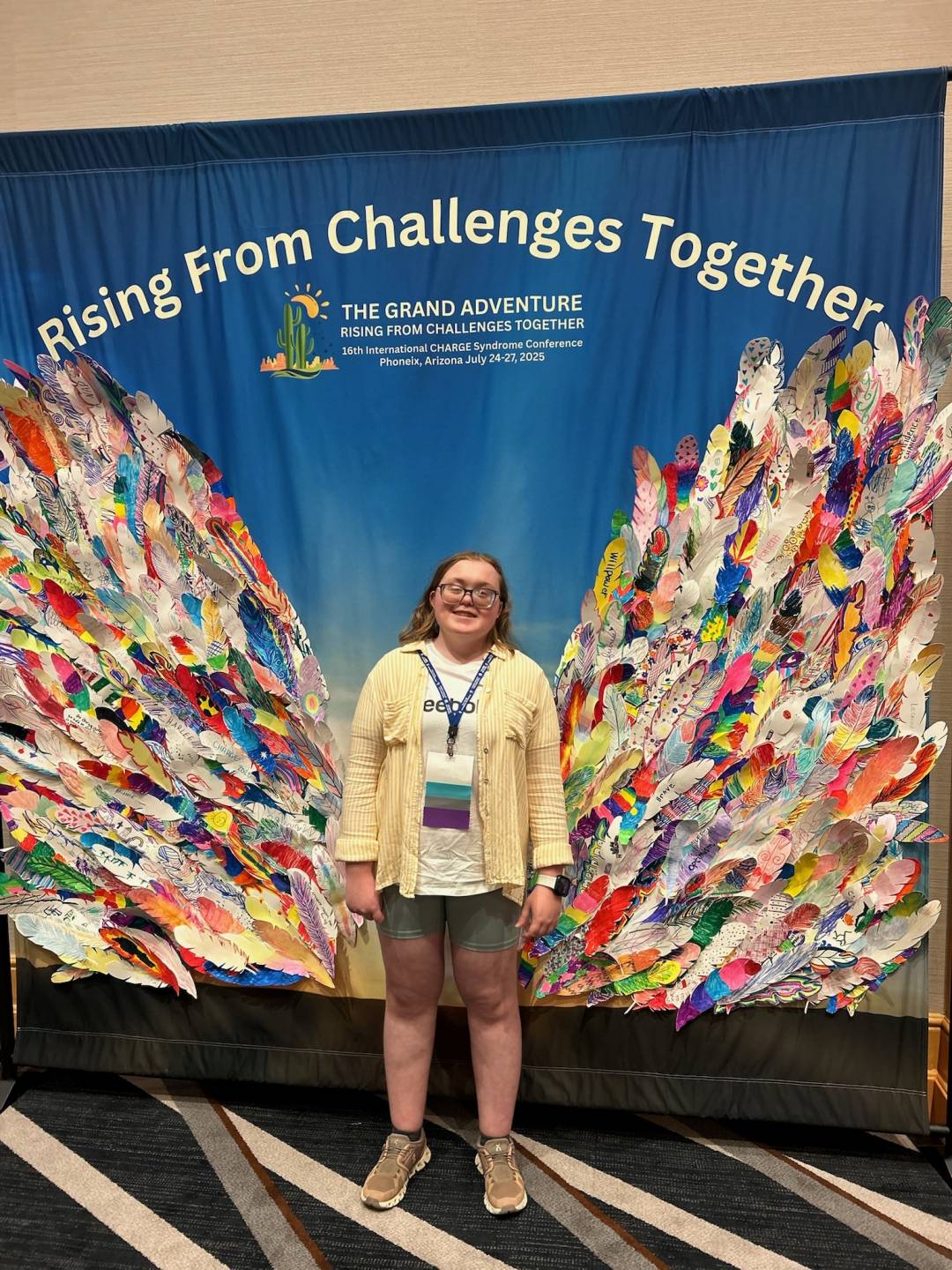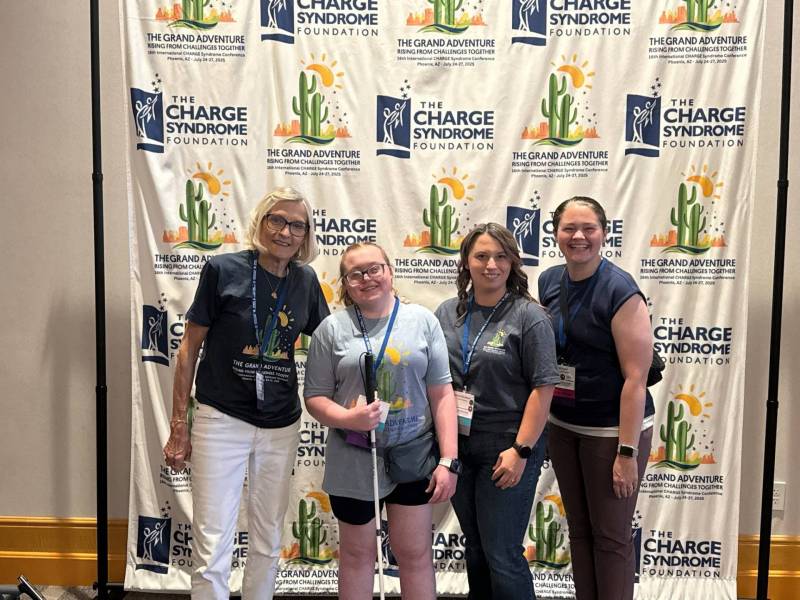 Not many teens would say that the highlight of their summer was attending a conference, but that’s exactly how 16-year-old Ryder Schlafman-Hieb feels. Ryder, who is starting her junior year at Carrington High School this month, attended the CHARGE Syndrome Conference in Phoenix, AZ, at the end of July with her mom, her TSVI Lanna Slaby, and Lacey Long, the Director of the North Dakota Dual Sensory Project. Ryder was born with CHARGE Syndrome, which stands for Coloboma, Heart defects, Atresia choanae, Retarded growth and development, Genital and/or urinary abnormalities, and Ear abnormalities and deafness. These characteristics vary widely among individuals and not every person will have all the features that make up the acronym. In Ryder’s case, CHARGE Syndrome has caused vision loss, hearing loss, and other physical issues, but, more importantly, she said, “it has offered me opportunities to meet new people.” This summer was no exception, as Ryder met hundreds of individuals of all ages who have CHARGE Syndrome, as well as professionals, including those who are researching CHARGE Syndrome and people working for the CHARGE Foundation.
Not many teens would say that the highlight of their summer was attending a conference, but that’s exactly how 16-year-old Ryder Schlafman-Hieb feels. Ryder, who is starting her junior year at Carrington High School this month, attended the CHARGE Syndrome Conference in Phoenix, AZ, at the end of July with her mom, her TSVI Lanna Slaby, and Lacey Long, the Director of the North Dakota Dual Sensory Project. Ryder was born with CHARGE Syndrome, which stands for Coloboma, Heart defects, Atresia choanae, Retarded growth and development, Genital and/or urinary abnormalities, and Ear abnormalities and deafness. These characteristics vary widely among individuals and not every person will have all the features that make up the acronym. In Ryder’s case, CHARGE Syndrome has caused vision loss, hearing loss, and other physical issues, but, more importantly, she said, “it has offered me opportunities to meet new people.” This summer was no exception, as Ryder met hundreds of individuals of all ages who have CHARGE Syndrome, as well as professionals, including those who are researching CHARGE Syndrome and people working for the CHARGE Foundation.
Ryder has attended this conference, which is held every odd year, in the past but had missed the last two that were held. “It was great to be back,” she said. “The conference always has great food, and it is a well-planned conference,” she explained. “I especially enjoy the planned evening events, and on Saturday night, there is always a CHARGE-a-palooza, and the theme this year was Glow Night!”
Besides the fun and socializing, Ryder learned more about her condition. “I think a person forgets how much the CHARGE Syndrome Foundation does throughout the year,” she said. “There are a number of research projects in the works to help with various issues that one with CHARGE can face.”
She also learned skills that will help her throughout her life. “One of the sessions I attended was called, ‘Understanding Financial Tools for Individuals with Disabilities: Public Benefits, Specials Needs Trusts, and ABLE Accounts,’” she shared. This session “helped me understand how these various financial tools can help me.”
Ryder also had the opportunity to present at the conference. “I presented on the technology I use to access my school work,” Ryder explained. “I wanted to give people some ideas or recommendations on technology that they could use to help them.” Ryder felt her presentation went well, with one person even commenting that it was one of the best sessions she attended at the conference this year.
Ryder is already looking ahead to the next conference in 2027 in Dallas, where she’d like to present again. “I’m thinking my topic could be transition as I’ll be a high school graduate by then,” she said. After graduation, Ryder wants to attend college and pursue a career in law enforcement. She believes that attending this conference where she can learn about her own disability helps her become a better advocate for herself. She encourages other students with CHARGE Syndrome and their parents to attend the conference as well. Doing so “would allow them to connect with other parents in person and make a real connection with others,” she explained. “Knowledge is Power!”
The Power of Connecting and Learning: Why families should consider attending a conference on their child’s disability
 NDVS/SB Regional Coordinator Lanna Slaby and Director of the ND Dual Sensory Project Lacey Long both attended the CHARGE Syndrome Conference with Ryder this summer. While it is not unusual for either of them to attend a summer conference, it was a different experience to attend a conference with a student and her parent, and on a specific disability. Both, however, found it incredibly beneficial. “I enjoyed learning information specific to the diagnosis,” Lacey said. “For example, at the CHARGE Conference, there were sessions with an ophthalmologist discussing vision loss related to CHARGE and an audiologist discussing hearing loss. The information that they shared would not have been shared anywhere else.” Lanna appreciated that the networking opportunities and the information learned benefits both you and your students. “The knowledge gained from a conference provides professional growth, and therefore better advocacy for your student,” she explained. Lanna, Lacey, and Ryder all agree that there are life-changing benefits by attending a conference about your child’s specific diagnosis. For more reasons why to consider attending one, read Lanna’s and Lacey’s answers below.
NDVS/SB Regional Coordinator Lanna Slaby and Director of the ND Dual Sensory Project Lacey Long both attended the CHARGE Syndrome Conference with Ryder this summer. While it is not unusual for either of them to attend a summer conference, it was a different experience to attend a conference with a student and her parent, and on a specific disability. Both, however, found it incredibly beneficial. “I enjoyed learning information specific to the diagnosis,” Lacey said. “For example, at the CHARGE Conference, there were sessions with an ophthalmologist discussing vision loss related to CHARGE and an audiologist discussing hearing loss. The information that they shared would not have been shared anywhere else.” Lanna appreciated that the networking opportunities and the information learned benefits both you and your students. “The knowledge gained from a conference provides professional growth, and therefore better advocacy for your student,” she explained. Lanna, Lacey, and Ryder all agree that there are life-changing benefits by attending a conference about your child’s specific diagnosis. For more reasons why to consider attending one, read Lanna’s and Lacey’s answers below.
Why do you think it is important for a student to attend a conference on their disability?
Lanna: The more you know about your disability the better you can advocate for yourself. And I think we are naturally drawn to people like us and the social connection with others who are like you. It makes one feel valued and accepted.
Lacey: Students with low-incidence disabilities, like visual impairments, can feel very isolated in the general education setting. That student can sometimes be the only student in their school or even the district with blindness/low vision. I think there is a huge benefit to connecting with others who have the same disability.
What did you learn at this conference, the CHARGE Syndrome Conference?
Lanna: There is an individual by the name of David Brown who has been working with individuals with CHARGE syndrome since 1983. He is a retired deafblind specialist who has a long list of credentials. One of his slides from his presentation was a reminder to us working with students who have CHARGE. It read: “A good and effective educational program, while being very positive and having high expectations, should always take account of the fact that everything that a child with CHARGE syndrome does is likely to take more thought, more attention, more concentration, more energy, and more time for them than it does for us.”
Lacey: My biggest takeaway from the conference was the value of gathering families with loved ones who all have the same diagnosis. Honestly, it was one of the best conferences that I’ve been to since I was able to see firsthand the importance of connecting families.
Have you attended conferences with students in the past?
Lanna: I had previously attended a CHARGE Conference in 2017, and now again in 2025, and I’m still in awe at how well this conference is organized. The Executive Committee, Board of Directors, and Advisors are so passionate and committed to the cause, you can’t help but be drawn into this community of parents and professionals. I think they shared that this group of people have over 125 years of combined service to this foundation.
Lacey: Although I have traveled with students in the past, this was my first conference that I attended with a family (the student and her mother). I enjoyed getting to know them on a more personal level beyond the technical assistance that I have been able to provide as part of the services available through the state’s deafblind project, the ND Dual Sensory Project.
If a parent or a student is interested in attending a conference on their disability, what would you suggest they do to prepare for it?
Lanna: I think most disability groups have a foundation and/or active social media groups that you’d want to join as this would provide you with lots of connections to other people.
Lacey: Supplemental funds from the ND Department of Public Instruction, Office of Specially Designed Services, through the ND Dual Sensory Project, along with additional funds, were available to support the family financially. The CHARGE Syndrome Foundation also sponsors families to attend.
